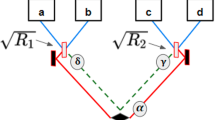Abstract
We consider the model of propagation of two particles created at one space point with correlated polarizations. Physical peculiarities of this process described in the framework of quantum electrodynamics are discussed in the context of quantum informatics.
Similar content being viewed by others
References
D. Bouwmeester, A. K. Ekert, and A. Zeilinger (eds.), The Physics of Quantum Information. Quantum Cryptography, Quantum Teleportation, Quantum Computation, Springer, Berlin (2000).
M. A. Nielsen and I. L. Chuang, Quantum Computation and Quantum Information, Cambridge Univ. Press, Cambridge (2000).
K. A. Valiev, “Quantum computers and quantum computations,” Phys. Usp., 48, 1–36 (2005).
M. Le Bellac, A Short Introduction to Quantum Information and Quantum Computation, Cambridge Univ. Press, Cambridge (2006).
N. N. Bogoliubov and D. V. Shirkov, Introduction to the Theory of Quantized Fields John, Wiley & Sons, New York (1980).
V. B. Berestetskii, E. M. Lifshits, and L. P. Pitaevskii, Course of Theoretical Physics, Vol. 4: Quantum Electrodynamics, Pergamon, New York (1982).
S. S. Schweber, An Introduction to Relativistic Quantum Field Theory, Dover, New York (2005).
C. Itzikson and J.-B. Zuber, Quantum Field Theory, McGraw-Hill, New York (1980).
M. E. Peskin and D. V. Schroeder, An Introduction to Quantum Field Theory, Addison-Wesley, Reading, MA (1995).
A. Einstein, B. Podolsky, and N. Rosen, “Can quantum-mechanical description of physical reality be considered complete?,” Phys. Rev., 47, 777–780 (1935).
J. S. Bell, “On the Einstein–Podolsky–Rosen paradox,” Physics Physique Fizika, 1, 195–200 (1964).
J. S. Bell, Speakable and Unspeakable in Quantum Mechanics, Cambridge Univ. Press, Cambridge (2004).
A. A. Grib, “Bell’s inequalities and experimental verification of quantum correlations at macroscopic distances,” Phys. Usp., 27, 284–293 (1984).
N. V. Evdokimov, D. N. Klyshko, V. P. Komolov, and V. A. Yarochkin, “Bell’s inequalities and EPR-Bohm correlations: Working classical radiofrequency model,” Phys. Usp., 39, 83–98 (1996).
A. Peres, “All the Bell inequalities,” Found. Phys., 29, 589–614 (1999).
K. Symanzik, “Schrödinger representation and Casimir effect in renormalizable quantum field theory,” Nucl. Phys. B, 190, 1–44 (1981).
V. N. Markov and Yu. M. Pis’mak, “Casimir effect for thin films in QED,” J. Phys. A: Math. Gen., 39, 6525–6532 (2006); arXiv: hep-th/0505218.
V. N. Marachevsky and Yu. M. Pis’mak, “Casimir–Polder effect for a plane with Chern–Simons interaction,” Phys. Rev. D, 81, 065005, 6 pp. (2010).
D. Yu. Pis’mak, Yu. M. Pis’mak, and F. J. Wegner, “Electromagnetic waves in a model with Chern–Simons ponential,” Phys. Rev. E, 92, 013204, 7 pp. (2015).
D. Yu. Pis’mak and Yu. M. Pis’mak, “Modeling the interaction of a material plane with a spinor field in the framework of Symanzik’s approach,” Theoret. and Math. Phys., 184, 1329–1341 (2015).
Acknowledgments
The author is grateful to A. A. Andrianov for the fruitful discussions.
Author information
Authors and Affiliations
Corresponding author
Ethics declarations
The author declares no conflicts of interest.
Additional information
Translated from Teoreticheskaya i Matematicheskaya Fizika, 2023, Vol. 217, pp. 77–85 https://doi.org/10.4213/tmf10478.
Rights and permissions
About this article
Cite this article
Pismak, Y.M. Entangled states in a simple model of quantum electrodynamics. Theor Math Phys 217, 1487–1494 (2023). https://doi.org/10.1134/S0040577923100057
Received:
Revised:
Accepted:
Published:
Issue Date:
DOI: https://doi.org/10.1134/S0040577923100057



